 uBitx multiband HF
uBitx multiband HF
A new HF transceiver from India is about to take to market, offering multiband operation 10 through to 80metres, with the inclusion of the WARC bands and general coverage receive.
Asharr Farhan the designer of the BITX20 and BITX40 has been working on the uBitx project for quite sometime. Demonstrations, and circuit details have been made available freely to anyone on his website Phonestack.com since early Spring 2017, for those who wished to scratch build the transceiver.
But Farhan, not resting on his recent success of producing the single band BITX40 (40m) transceiver, that introduced many to HF for a small price a point of "$59" including a recent addition of stable DDS, which he called the Raduino. VU2ESE has now put the uBitx into production, and I understand will be made available soon from his HF Signals website for purchase. (Currently the website only shows the current 40m radio for sale).
Above, a recent tested production run of uBitx transceiver boards.
The uBitx will offer CW and SSB, with 10W output from a pair of IRF510's. Arduino derived stable DDS using a Si5351 for all the local oscillators.
What you will get in the package will be a fully built and tested board. My guess is it will be sold with a similar hardware package that was included with the BITX40, which will include the wiring hardware, connectors, pots, power and BNC connectors for the antenna etc. All you will have to do is wire it up, add a speaker and a case to complete the project.
The price for the uBitx has yet to be announced? But again my guess is it will be one of it's major success stories that will take the HF world by storm and introduce many to the affordable world of HF operation. Of course, I expect it will cost more than the BITX40, but you will be getting access to most of the HF spectrum, for something until now that has proved undeliverable to those on small budgets.
Exciting times, keep watching HF Signals for further details.
Steve, G1KQH, is a regular contributor to AmateurRadio.com and writes from England. Contact him at g1kqh@arrl.net.
 Amateur Radio Weekly – Issue 184
Amateur Radio Weekly – Issue 184
This weekend: ARRL 10 meter contest
The objective is for Amateurs worldwide to exchange QSO information with as many stations as possible on the 10 meter band.
ARRL
WSPR Beacon Rocket is launched into near space
I launched a WSPRLite beacon on my hobby rocket at the Dec 2nd rocket launch in Samson, Alabama.
N4KGL
Review: RTL-SDR Blog Multipurpose Dipole Antenna Kit
Four antennas, two mounts, one antenna holder with cable and one more extension cable. Costs $10 on its own.
Radio for Everyone
10 watt moonbounce success
The contact was made using a Yaesu FT-857 @ 10w into a DG7YBN 70-17m 17 element yagi on a frequency of 432.063MHz
Essex Ham
My love for analog FM
C4FM & DMR Repeaters have popped up all over the nation it seems.
K5ACL
Mic amp
I connected my d104 mic to it and hooked it up to the scope and the scope pattern looks good.
awsh.org
Building a WA5VJB cheap Yagi for satellite work
I took a Baofeng UV-5R and built a WA5VJB cheap Yagi which is also used in AMSAT demos at hamfests.
galvanix
EMP protection for the Radio Amateur
What is an EMP, why should you care, and what to do about them?
Off Grid Ham
Reducing SD card writes with Raspbian
A common concern of those running applications on a Raspberry Pi is SD Card exhaustion.
K2DLS
Morse Chrome
Chrome browser extension for Morse Code
Ham Radio QRP
Video
WSJTX & FT8 the easy way with the Icom 7300
For beginners or people who don’t want the work of integrating JTAlert and/or QSORelay and a logbook. The easiest way to make FT8 contacts.
K0PIR
Pakratt PK64 on the Commodore 64 connected to raspberry pi BPQ
Testing connections to my local BBS and another BBS in the area using my commodore 64 and a PK-64 Pakatt TNC connected to a remote raspberry pi bpq over the packet modem.
YouTube
Amateur Radio Weekly is curated by Cale Mooth K4HCK. Sign up free to receive ham radio's most relevant news, projects, technology and events by e-mail each week at http://www.hamweekly.com.
 Everything Ham radio podcast Ep 93 – NASA On The Air(NOTA)
Everything Ham radio podcast Ep 93 – NASA On The Air(NOTA)
I’m sure that you have heard of NPOTA, National Parks On The Air, and SOTA, Summits On The Air, and probably even POTA, Parks On The Air, The US program for the World Wide Flora and Fauna, but have you heard of the latest event that starts on Sunday, Dec 11, 2017?
Starting at 0000 UTC time on December 11, 2017 the new year long event celebrating multiple anniversaries for the NASA program will start. It is called NOTA or NASA On The Air.
With several NASA clubs doing several special event stations of the coming year, they decided to make a year long event where you, as the end user, can contact the stations to earn points through the year. You can even gets points during other events like Winter Field Day, the ARRL Field Day and others.
Losten to my latest podcast episode where I talk with Rob Suggs about it:
http://www.everythinghamradio.com/Podcast/93
Curtis Mohr, K5CLM, is the author/owner of Everything Ham Radio Blog and Youtube channel. Contact him at k5clm@everythinghamradio.com.
 Today’s Space Weather Forecast Discussion (2017 Dec 07 1230 UTC)
Today’s Space Weather Forecast Discussion (2017 Dec 07 1230 UTC)
Here is the current forecast discussion on space weather and geophysical activity, issued 2017 Dec 07 1230 UTC.
Solar Activity
24 hr Summary: Solar activity continued at very low levels. Region 2690 (N07W23) decayed into a plage region. No Earth-directed CMEs were observed in available satellite imagery.
Forecast: Solar activity is expected to continue at very low levels over the next three days (07-09 Dec).
Energetic Particle
24 hr Summary: The greater than 2 MeV electron flux was at normal to high levels today with a maximum flux of 3,260 pfu observed at 06/1735 UTC. The greater than 10 MeV proton flux was at background levels.
Forecast: The greater than 2 MeV electron flux is expected to be at moderate to high levels for the next three days due to CH HSS influence. The greater than 10 MeV proton flux is expected to continue at background levels for the forecast period.
Solar Wind
24 hr Summary: Solar wind parameters indicated the continued influence of a positive polarity CH HSS. Solar wind speed decreased from approximately 635 km/s to near 525 km/s over the period. Total field ranged from 2 to 6 nT while the Bz component was between +3/-5 nT. Phi angle was oriented in a mostly positive solar sector.
Forecast: Solar wind parameters are expected to continue to be enhanced under a positive polarity CH HSS through day one. A slow return to nominal levels is expected on days two and three as HSS effects wane.
Geospace
24 hr Summary: The geomagnetic field was quiet to unsettled.
Forecast: The geomagnetic field is expected to be at quiet to unsettled levels on days one and two, followed by mostly quiet levels on day three as CH HSS effects diminish.
Don’t forget to visit our live space weather and radio propagation web site, at: http://SunSpotWatch.com/
Live Aurora mapping is at http://aurora.sunspotwatch.com/
If you are on Twitter, please follow these two users:
+ https://Twitter.com/NW7US
+ https://Twitter.com/hfradiospacewx
Check out the stunning view of our Sun in action, as seen during the last five years with the Solar Dynamics Observatory (SDO): https://www.youtube.com/watch?v=zXN-MdoGM9g
-=-=-=-=-=-
What’s the difference between CB & amateur (ham) radio? Here ia a video with an opinion by our curator, Tomas (amateur radio operator, NW7US): Did NCIS TV Show Malign the Amateur Radio Service? https://www.youtube.com/watch?v=pIWJ7kKbxiM?t=1m33s
-=-=-=-=-=-
If you are on Twitter, please follow these two users:
+ https://Twitter.com/NW7US
+ https://Twitter.com/hfradiospacewx
We’re on Facebook: http://NW7US.us/swhfr
Visit, subscribe: NW7US Radio Communications and Propagation YouTube Channel
 General License Class: Black Forest, CO Feb 24/Mar 3
General License Class: Black Forest, CO Feb 24/Mar 3
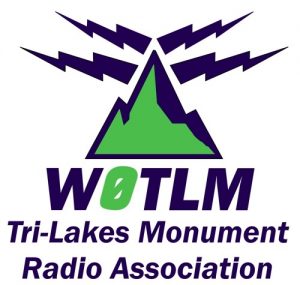 Sat Feb 24 and Sat Mar 3 (8 AM to 5 PM) 2018
Sat Feb 24 and Sat Mar 3 (8 AM to 5 PM) 2018
Black Forest Fire Station
11445 Teachout Road
Colorado Springs, CO 80908
The General License provides access to regional and worldwide communications on the HF bands, greatly expanding your ham radio fun!
• Upgrade from Technician to General Class radio privileges
• Pass your FCC General Class amateur license exam Mar 10*
• Live equipment demonstrations and activities
• Learn to operate on the HF bands, 10 Meters to 160 Meters
• Gain a deeper understanding of radio electronics and theory
• Take the next step with antennas, amplifiers, digital modes
Registration fee: $30 ($20 for under 18 years of age)
Students must have the required study guide: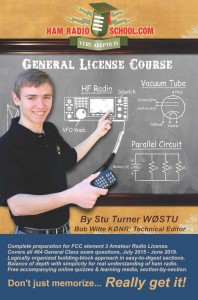
HamRadioSchool.com General License Course
Second Edition, effective 2015 – 2019, $22.95
* Free FCC exam session on Mar 10 at Black Forest Fire Station 9:30 am.
To register for the class, email: Bob KØNR bob@k0nr.com
Sponsored by the Tri-Lakes Monument Radio Association
The post General License Class: Black Forest, CO Feb 24/Mar 3 appeared first on The KØNR Radio Site.
Bob Witte, KØNR, is a regular contributor to AmateurRadio.com and writes from Colorado, USA. Contact him at bob@k0nr.com.
 Upcoming ’29 BK QSO Party
Upcoming ’29 BK QSO Party
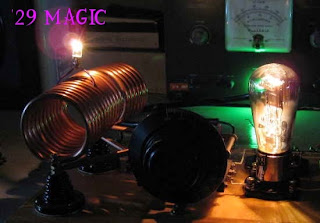 |
| courtesy: Lou, VE3AWA |
This Saturday night as well as the next will be the annual Bruce Kelley 1929 QSO Party, otherwise known as the '1929 BK'.
Only transmitters that are 'era-appropriate' are allowed to be used. More specifically, transmitters must employ tubes that were available in 1929 or earlier, and transmitters must be self-excited. No crystals allowed! Crystals were new and largely unaffordable for most hams back in the depression days.
1929 marked a real turning point in amateur radio as governments finally cracked-down on things such as frequency stability, out of band operations and re-alignment of call districts. In short, hams were henceforth required to behave themselves and to clean up their signals and methods of operation.
 |
| courtesy: http://www.arrl.org/ |
If you tune across the CW bands during the next two Saturday nights, you will have the rare opportunity to hear exactly what the bands must have sounded like back in the early '30s'.
For the most part you will hear single tube Hartley, Colpitts or TNT oscillators along with a few two-tube MOPAs thrown in. Many of them will suffer the same problems encountered by the boys of '29 ... chirp, drift, buzzy notes and frequency instability from antennas swaying in the wind.
This year, signals should be a little louder as well, since the previous power limitation of 10W input has been increased to 25W.
The MOPAs will sound much better but some surprisingly nice-sounding signals can be heard coming from properly tuned and optimised single-tube oscillators. I recall being blown away by the lovely sounding signal I heard from such a rig when first tuning into the BK activity several years ago, only to learn that it was a self-excited Hartley using 1/4" copper tubing for the oscillator tank circuit!
The '29 watering-hole on 80m will be around 3550-3580 kilocycles (be careful not to confuse this with kilohertz!) while the early afternoon to post-sunset 40m activity will be found from 7100-7125 kc. There may even be a few on the very low end of 160m. Although many of these transmitter styles were used on 20m and higher, BK rule-makers have wisely decided not to inflict these sounds on the present populace as it would likely keep the 'Official Observers' busy for several days writing pink-slips.
You can learn more about amateur radio happenings leading up to and following the 1929 crackdown in my earlier series of 'Why '29' blogs here:
Part 2
Part 3
Part 4
Those wishing to put something together for next year's event can find everything needed here:
Building '29-Style - Part 1
Building '29-Style - Part 2
Let's hope for good conditions for this event as the last few years have been adversely affected by geomagnetic storming. Poor propagation or not, I guarantee there will be plenty of '29ers busy calling 'CQ AWA' on the low bands.
Steve McDonald, VE7SL, is a regular contributor to AmateurRadio.com and writes from British Columbia, Canada. Contact him at ve7sl@shaw.ca.
 Pikes Peak SOTA (W0C/FR-004) Winter Activation
Pikes Peak SOTA (W0C/FR-004) Winter Activation
Joyce/K0JJW and I had intended to hike Pikes Peak this year for a Summits On The Air (SOTA) activation but somehow the plan never came together. I still had my eye on it as a drive-up activation before the end of 2017. The road to the summit is open year round now but closes frequently due to snowstorms passing through. Saturday morning the road was open to 13 miles (out of 19 miles) with the promise that it would be open to the summit later in the morning. (Call 719 385-7325 for a recorded message on road conditions.) By the time we got to the toll gate around 10 am, the road was open to the summit.
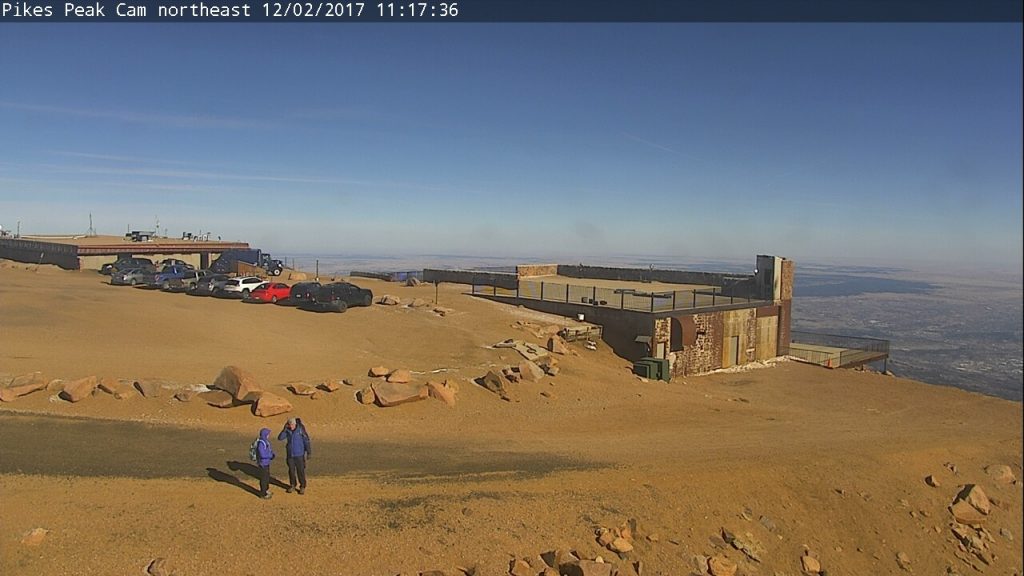
When we reached the summit, the weather conditions were 20 deg F with 20 mph winds, creating a windchill of 4 deg F. We were prepared for that having loaded up on the winter clothing. Still, it was freaking cold up there. As you can see in the webcam picture, there was only traces of snow on the summit.
To be SOTA-compliant, we had all of our gear loaded into our packs and walked some distance away from our vehicle to set up. Because of the wind, we chose the observation platform, tucked in behind one of the walls. Normally, that platform is to be avoided because its overrun with tourists but with the cold weather we only had a few people to contend with.
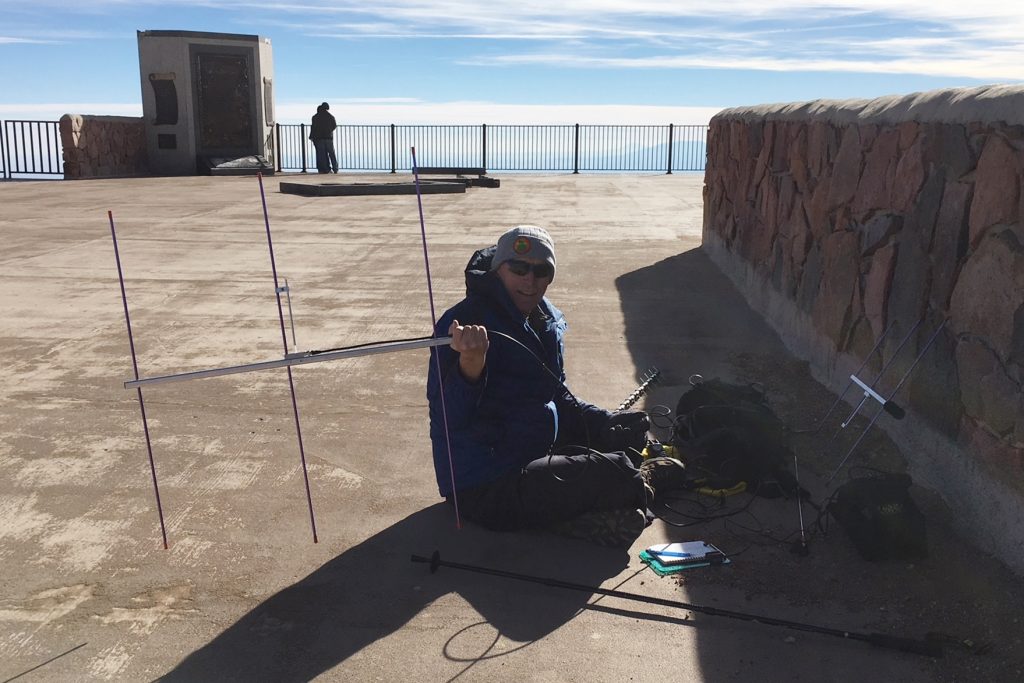
Joyce set up on 2m fm (146.52) using a handheld transceiver (HT) with a vertical antenna. Even with her headset (foam protection on the microphone), the wind noise on her signal was significant. I started out on 2m fm but quickly moved up to 223.5 MHz and worked a few stations there, then on to 446.0 MHz. I had HTs and small yagi’s on both of those bands. Then I fired up 1.2 GHz with an Alinco HT (just 1W on that band) and a 16-element yagi. I worked Paul/W0RW, Gary/WB5PJB and Wayne/N0POH on that band. My QSO with N0POH in Aurora was a new personal best for distance on 23cm/1.2 GHz, at about 90 km.
I tried 2m SSB using my FT-817 but made only one contact: Jim/WB0GMR. Shortly thereafter, I switched back to 2m fm using the 25W mini-mobile rig with a 3-element yagi to work many more stations. Again, just running a bit of power and having a decent antenna on 2m fm was very effective at making radio contacts. I expected the Tytera radio to be overloaded with signals on the summit of Pikes but it actually held up well with just occasional bursts of interference.
Overall, we made 54 QSOs (not too shabby): 43 QSOs on 2m, 5 QSOs on 70cm and 3 QSOs on both 1.25m and 23cm. Our best DX was Jeff/N0XLF near Akron, CO for a distance of about 130 miles (on 2m and 70cm).
73, Bob K0NR
The post Pikes Peak SOTA (W0C/FR-004) Winter Activation appeared first on The KØNR Radio Site.
Bob Witte, KØNR, is a regular contributor to AmateurRadio.com and writes from Colorado, USA. Contact him at bob@k0nr.com.

















